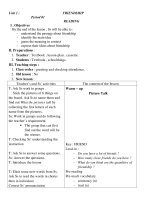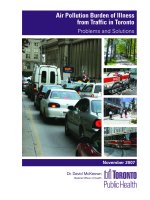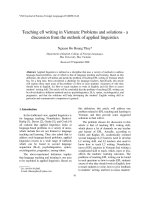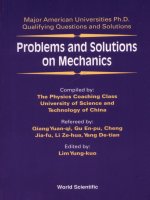- Trang chủ >>
- Mầm non - Tiểu học >>
- Lớp 5
5 14 new problems new solutions
Bạn đang xem bản rút gọn của tài liệu. Xem và tải ngay bản đầy đủ của tài liệu tại đây (4.53 MB, 10 trang )
Fascinating Facts
•
Between 1750 and 1850 the population of Europe
doubled. This contributed to immigration to
America’s cities.
•
In the early 1900s increasing numbers of automobiles
contributed to the continuing growth of traffic problems
in cities. In 1901 New York State became the first state
to require automobile license plates.
•
In 1931 Jane Addams became the second woman to
receive the Nobel Peace Prize.
Genre
Nonfiction
Comprehension Skill
Sequence
Text Features
• Graph
• Political Cartoon
• Time Line
Scott Foresman Social Studies
ISBN 0-328-14904-7
ì<(sk$m)=bejaej< +^-Ä-U-Ä-U
In the late 1800s and early 1900s, more and more
people crowded into cities in the United States.
People were moving away from rural areas, and
there was a dramatic rise in immigration. In
this book you will learn about the problems this
created and what solutions were offered to try to
overcome the problems.
Vocabulary
Write to It!
Many people worked and many organizations
were started and to help solve problems during
the late 1800s and early 1900s. Of the people and
organizations mentioned in this book that were
involved in solving the problems, pick one and find out
more about that person or organization. Write two or
three paragraphs about what you learn.
urbanization
mechanization
Write your ideas on a separate sheet of paper.
tenement
epidemic
settlement house
suspend
Photographs
Every effort has been made to secure permission and provide appropriate credit for photographic material.
The publisher deeply regrets any omission and pledges to correct errors called to its attention in subsequent editions.
BY KRISTIN CASHORE
Unless otherwise acknowledged, all photographs are the property of Scott Foresman, a division of Pearson Education.
Photo locators denoted as follows: Top (T), Center (C), Bottom (B), Left (L), Right (R), Background (Bkgd).
ISBN: 0-328-14904-7
Copyright © Pearson Education, Inc.
All Rights Reserved. Printed in the United States of America. This publication is protected
by Copyright, and permission should be obtained from the publisher prior to any prohibited
reproduction, storage in a retrieval system, or transmission in any form by any means,
electronic, mechanical, photocopying, recording, or likewise. For information regarding
permission(s), write to: Permissions Department, Scott Foresman, 1900 East Lake Avenue,
Glenview, Illinois 60025.
1 2 3 4 5 6 7 8 9 10 V0G1 14 13 12 11 10 09 08 07 06 05
Opener: ©Corbis
3 ©Getty Images
Editorial Offices: Glenview, Illinois • Parsippany, New Jersey • New York, New York
5 ©Corbis
6 ©The Granger Collection,
NY Offices: Needham, Massachusetts • Duluth, Georgia • Glenview, Illinois
Sales
7 ©The Granger Collection, NY
Coppell,
Texas • Sacramento, California • Mesa, Arizona
8 ©Bettmann/Corbis
9 ©National Cancer Institute
11 ©Bettmann/Corbis
12 ©Corbis
13 ©Bettmann/Corbis
14 ©Bettmann/ Corbis
People from rural areas were moving to the cities to find
jobs. In the 1800s mechanization had revolutionized farming.
Machines now did much of the work that people once did by
hand. Mechanical plows, reapers, and milking machines made it
unnecessary for farmers to hire so many workers. Farmers could
plant many more acres and milk more cows with fewer people to
help. They could now feed far more people than ever before.
This meant that there were suddenly a lot of farm workers
without jobs.
Cities were where jobs could be found. Factories were hiring
hundreds of workers, and the growing populations needed services,
from selling groceries to making clothes to sweeping streets.
Almost all cities in the United States saw growth during this
period, but some cities grew dramatically.
Moving to the Cities
The United States grew all through the 1800s. However, in the
late 1800s, while the number of people continued to increase,
where and how people lived began to change too.
During its early history, the United States was largely a rural,
agricultural nation. Most Americans—at least 85 percent of
them—lived on farms or in rural communities near those farms in
1850. Farms were small, and most people could only raise enough
food for themselves. It took a lot of work, and a lot of workers, to
raise enough crops to provide food for nearby towns.
In the late 1800s people who had lived in the country all
their lives started moving to the city. This move from rural
areas to cities, or urbanization, would change the United States
dramatically. The country was becoming a nation of city dwellers.
2
In the late 1800s and early 1900s, urbanization contributed to the
rapid growth of cities in the United States.
3
People in other countries also heard about the jobs in America’s
cities. Between 1890 and 1910, more than 10 million immigrants
flooded into the country. Never before had so many come to
the United States in such a short period of time. This burst of
immigration contributed further to the rapid growth of the cities.
Unfortunately, there were not enough jobs for everyone.
Immigrants were often willing to work for lower wages, which meant
they took jobs away from American workers. This angered many
workers. Labor organizations and other groups often tried to keep
immigrants from entering the country. The Know-Nothing Party
was powerful in American politics in the early 1850s. This group
protested angrily against cheap labor from other countries.
Job shortages and protestors were not the only problems in the
cities. People would soon have to face a wide range of issues as
populations continued to grow.
The Know-Nothing Party held meetings to try to stop immigrants
from taking American jobs.
Some Events that Changed City Life
in the United States
1882
First power
station opened
in New York.
1852
Elisha Graves
Otis creates
the first safety
elevator.
1845
World’s first modern
suspension bridge
completed in
Pittsburgh, PA.
1840
1850
1885
1897
First skyscraper
completed in
Chicago.
Country’s first
successful
subway system
opened in
Boston, MA.
1891
1871
James
Naismith
invents
basketball.
Great Chicago
Fire
1860
1870
1880
1890
1856
English inventor Henry
Bessemer invents a new way
of producing strong steel at
affordable prices.
4
1889
1887
Jane Addams
opens Hull
House.
Joseph Kinyoun builds a laboratory
that is the foundation of the
National Institutes of Health.
5
1900
This image shows
what a New York
City tenement
looked liked
around 1910.
Cities were growing so fast that there were few services in
place to take care of such things as garbage removal. Soon
streets and rivers were filthy and unsafe. There were also
few parks and few places children could play, and there were
not enough police or firefighters. The cities were becoming
dangerous.
Because so many people were living so closely together,
diseases spread quickly. The tenement buildings were the worst
places, but disease soon affected everyone. Epidemics, or rapid
spreading, of polio, tuberculosis, smallpox, cholera, and typhoid
fever killed thousands of people. In the South thousands died
from yellow fever. Influenza killed over 500,000 Americans in
1918. Clearly, something had to be done.
Opportunity and Hardship
The United States was seen as the land of promise.
Because of increased opportunities, many poor people, both
Americans and immigrants, improved their lives during this
period. They worked hard, and many succeeded. Some even
became very wealthy.
With more people earning and spending money, more
opportunities opened up. America became the most productive
nation in the world. However, not every story was a success story,
and people faced growing problems created by the increasing
size of the cities.
Many immigrants and rural poor who had come to the city
worked endlessly but could not escape poverty. A lack of skills
or education trapped many in low-paying jobs. As more people
arrived, housing became difficult to find. Buildings were divided
into smaller and smaller apartments, and large families often
crowded into these tiny tenements.
New tenement buildings were built rapidly, as the need for
housing continued to increase. Some were badly constructed.
Some lacked heat, and some even lacked windows.
6
One problem of rapid urban growth was a lack of facilities for
children, both for play and for school.
7
Help Is on the Way
Individuals, organizations, and city and federal governments
worked hard trying to solve the problems. Organizations such as
the YMCA, YWCA, and the Salvation Army—still well-known today—
got started during this time. Immigrants who had succeeded
offered help to others coming from their respective homelands.
The idea of public health was introduced. City governments
began cleaning up the streets. In 1870 Congress created a
national health agency. New immigrants arriving in the late 1800s
were checked for contagious diseases. Authorities treated those
who were sick before letting them move into the cities. In New
York City, Dr. Joseph Kinyoun set up a laboratory in 1887, so he
Scoring Points for Health
James Naismith worked at the YMCA in Springfield, Massachusetts
and later taught college. He believed that exercise was important for
health, but he also thought it should be fun. He was worried about
the lack of opportunity for physical exercise for city children during
the winter. So in 1891, with a leather ball and two peach baskets, he
created a new game—basketball. It was an instant success. It spread
across the country and around the world.
James Naismith invented the game
of basketball to give city children
something they could play
indoors during the winter.
This laboratory was set up by 27-year-old Joseph Kinyoun, a doctor who
wanted to study diseases that were epidemic in the United States.
could study the contagious diseases that were killing so many
people. In 1891 Kinyoun moved his laboratory to Washington,
D.C. Congress funded research and new facilities, and in time the
small laboratory grew into the National Institutes of Health.
Jane Addams started her famous settlement house, Hull
House, in Chicago in 1889. Many people admired her efforts to
help poor immigrants and imitated her work.
In 1890 Jacob Riis, an immigrant from Denmark, published a
book of photographs titled How the Other Half Lives. The book’s
shocking pictures of the urban poor had a powerful effect. The
work of Riis and other reformers resulted in New York State’s
Tenement House Act of 1901. This law required much stronger
safety and health standards for tenements.
9
Political Machines Are Created
Improvements were being made, but cities still needed better
streets, more housing, and better sewage disposal. Because
of workers who worried that immigrants were taking jobs away
from Americans, immigrants often needed help finding jobs. City
governments struggled to meet these needs, but change was not
happening as fast as the cities were growing.
Some people took advantage of the situation, and political
machines were formed. A political machine is an organization of
people who control votes to gain political power. Members of the
political machines wanted to get candidates they had chosen
elected to city offices, so they promised immigrants that they
would help them if the immigrants would vote for the candidates
the political machine had chosen. Once elected, the machinepicked candidates did what the political machine told them to do.
They helped other members of their political machine gain power
and wealth.
A powerful political machine in New York City was Tammany
Hall. Perhaps the most famous Tammany leader was “Boss”
William M. Tweed. He was known for bribing leaders and cheating
people out of money. However, when he stole millions of dollars
from the city, he finally went to jail.
Political machines also arose in Boston, Philadelphia,
Pittsburgh, Chicago, and other cities. Although most political
machines were dishonest and influenced by bribes, many
immigrants wanted their help. They were glad that someone
seemed to be taking their side. And some political machines did
work to improve things. They may have hired only members of the
political machine, or accepted bribes for contracts, but streets
did get built, services were expanded, and jobs were created. But
these things happened more slowly, and at greater cost, because
of the corruption of the political machines.
10
This political cartoon shows “Boss” Tweed welcoming a
cholera epidemic. Political machines benefited from the
suffering of others.
11
Too Many People, Too Little Space
Efforts were being made to improve health and education.
Many people were working to make life better for the poor and
to create cleaner, prettier cities. But cities were still running
out of space.
People needed more than buildings to live in. They needed
water, sewers, and garbage collection. They needed stores,
doctors, and post offices.
Cities had a limited amount of land on which to build. As
urban populations increased, space became a real problem.
What could be done?
Otis developed the safety
elevator, an elevator that
would stop if the cable
broke. Here you can
see the patented brake
attached to the cable
that holds the elevator.
Moving Up, Moving Out
Two things came together to help cities create more space.
The first was the invention of the safety elevator. Elevators were
not new, but initially there was no way to stop them if they fell.
So elevators were used to move products, not people. Then
Elisha Graves Otis invented a braking system for elevators. If the
elevator cable broke, his system would grip the tracks on either
side of the elevator, bringing the elevator to a stop. People could
now ride safely. Otis installed the first passenger elevator in a
five-story department store in New York City in 1857.
The second part of the solution was affordable steel. The
Bessemer process for producing steel had been brought to the
United States by Andrew Carnegie in the 1870s, so good steel
was suddenly widely available. A building supported by a steel
frame could grow very tall. Steel and elevators made it possible
to build taller buildings. A city could now expand upward.
12
13
Subways made it
possible to move people
through the city beneath
the crowded streets.
In 1871 the Great Chicago Fire destroyed
Chicago’s downtown area, so Chicago seemed
like a good place to start experimenting with
taller buildings, or “skyscrapers.” The first
skyscraper, the Home Insurance Building, was
completed in Chicago in 1885. At ten stories tall,
it was the tallest building in the country. Taller
buildings were soon being constructed.
Rivers posed another problem. Being near
water transportation was a key reason for the location of many
big cities. Many cities had rivers running either through or
alongside them. It was hard to build bridges without making it
even harder to use the river.
Suspension bridges—bridges that are suspended, or hung,
from massive overhead cables—were a relatively new idea. It
was a challenge to create stable, strong suspension bridges that
could survive heavy traffic. John Roebling, a German immigrant
and building engineer, solved the problem by combining new
building methods with a strong, steel cable he had developed.
After he built the first successful steel suspension bridges, New
York State asked him to design the Brooklyn Bridge. Sadly, he
died before this bridge was completed. His son, Washington,
finished the bridge. After he became ill, Washington was assisted
in his work by his wife, Emily. When it opened in 1883, the
Brooklyn Bridge was the longest bridge in the world.
Cities also began to create new forms of public transportation.
Some cities built elevated trains, trains that were supported by
steel structures that held them one or two stories above street
level. New York’s elevated train opened in 1870 and Chicago’s
in 1892.
Next, engineers began to consider going down, under the
streets. Many cities began experimenting with this idea, but it
was Boston, Massachusetts that, in 1897, opened the country’s
first successful underground train system, or subway.
The late 1800s through early 1900s was the period that
gave us much of what we consider normal for big cities today,
from traffic jams to skyscrapers to subways. And today, city
governments still struggle to keep up with city growth—and
immigrants continue to arrive, looking for opportunities.
14
15
In the late 1800s and early 1900s, more and more
people crowded into cities in the United States.
People were moving away from rural areas, and
there was a dramatic rise in immigration. In
Glossary
this book you will learn about the problems this
createdthe
and
what
solutions
offered
to try
to
epidemic
rapid
spread
of a were
disease,
so that
many
overcome
problems.
people
havethe
it at
the same time
mechanization the use of machines to do work
settlement house a place
that provides help for
Vocabulary
immigrants and the poor
urbanization
suspend to hang by fastening to something above
mechanization
tenement a building divided into many small apartments
tenement
urbanization the movement of people from rural areas
epidemic
to the city
settlement house
Write to It!
Many people worked and many organizations
were started and to help solve problems during
the late 1800s and early 1900s. Of the people and
organizations mentioned in this book that were
involved in solving the problems, pick one and find out
more about that person or organization. Write two or
three paragraphs about what you learn.
Write your ideas on a separate sheet of paper.
suspend
Photographs
Every effort has been made to secure permission and provide appropriate credit for photographic material.
The publisher deeply regrets any omission and pledges to correct errors called to its attention in subsequent editions.
Unless otherwise acknowledged, all photographs are the property of Scott Foresman, a division of Pearson Education.
Photo locators denoted as follows: Top (T), Center (C), Bottom (B), Left (L), Right (R), Background (Bkgd).
ISBN: 0-328-14904-7
Copyright © Pearson Education, Inc.
All Rights Reserved. Printed in the United States of America. This publication is protected
by Copyright, and permission should be obtained from the publisher prior to any prohibited
reproduction, storage in a retrieval system, or transmission in any form by any means,
electronic, mechanical, photocopying, recording, or likewise. For information regarding
permission(s), write to: Permissions Department, Scott Foresman, 1900 East Lake Avenue,
Glenview, Illinois 60025.
1 2 3 4 5 6 7 8 9 10 V0G1 14 13 12 11 10 09 08 07 06 0516
Opener: ©Corbis
3 ©Getty Images
5 ©Corbis
6 ©The Granger Collection, NY
7 ©The Granger Collection, NY
8 ©Bettmann/Corbis
9 ©National Cancer Institute
11 ©Bettmann/Corbis
12 ©Corbis
13 ©Bettmann/Corbis
14 ©Bettmann/ Corbis









